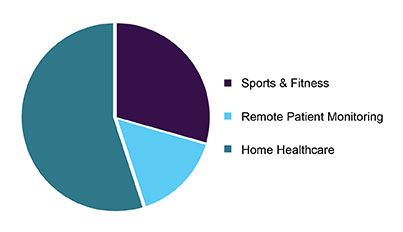As per Grandview Research, the global wearable medical device market size was valued at USD 10.3 billion in 2018 and expected to witness a CAGR of 26.1% over the forecast period. Increase in health and fitness awareness, coupled with the latest advances in technology, has resulted in the development and adoption of portable healthcare devices and remote patient monitoring. The below chart published by Grandview research indicates the global wearable medical device market share by application.
 Hectic and stressful lifestyle has resulted in increase in multiple health disorders. In today’s fast-moving world, people prefer to have quick access to monitoring and diagnostics devices. Portable medical devices have revolutionized the way in which people monitor and determine their own health and wellbeing. These devices can’t just provide continuous and non-invasive monitoring of health parameters, but through connectivity they also provide real-time updates to healthcare providers.
Hectic and stressful lifestyle has resulted in increase in multiple health disorders. In today’s fast-moving world, people prefer to have quick access to monitoring and diagnostics devices. Portable medical devices have revolutionized the way in which people monitor and determine their own health and wellbeing. These devices can’t just provide continuous and non-invasive monitoring of health parameters, but through connectivity they also provide real-time updates to healthcare providers.
Here are a few examples of portable devices that are trending in this domain:
Blood Pressure Monitors
Blood Pressure Monitoring has become a routine for people having the tendency of high/low blood pressure. Wireless BPMs are highly portable and they attach to your upper arm, use smart technology to record, and monitor your blood pressure.
Glucose Monitoring Systems
Smart, portable glucose monitoring systems let you measure the glucose levels in your blood on the go. The smart element is that these little devices can connect to your smartphone in order to monitor your blood sugar levels over time and share them with a doctor.
The benefit of being able to test your glucose levels remotely is that you can do so before and after exercise, meals out, or in any situation that you might need to do so remotely without the usual blood test.
Automated Insulin Pumps
People suffering from type 1 diabetes need to replenish their insulin stock with multiple daily injections or through a catheter. Unlike these manual techniques, the latest automated insulin pump system continuously tracks the glucose levels and then adjusts insulin levels with little or no input from the user.
Portable EKG/ECG Monitors
Portable EKG/ECG monitors assess heart activity used during electrocardiogram tests. While traditional models would display data as graphical lines on paper, the latest compact version includes LCD screens and sensors to let you view results in real time by taking your pulse via your fingers with an accompanying mobile application.
Key considerations for portable medical device development
Hardware
Once the problem statement and use case is determined, the hardware architecture has to be finalized. Product features and performance requirement defines the processor selection. It can range from an 8-bit microcontroller to feature-rich systems on chips (SoCs) comprising of multi-cores or digital signal processors (DSPs).
Low power ARM Cortex-M/A processors are ideal for the smaller devices because of their small form factor and minimal power requirements. Complex portable devices that require graphical user interface and wireless connectivity require powerful processors like Qualcomm Snapdragon. These portable devices need to be compact; this is achieved by packing multiple components in small space. However, hardware design also needs consider sink design to dissipate waste heat.
Operating System (OS)
Android and Linux OS have been the preferred choice for most of the portable medical devices due to their highly customizable and advanced features for compute, performance and power. However, to ensure power and memory optimization, the OS must be optimized with a small memory footprint. Most real-time operating systems will provide some form of power management techniques that need to be implemented as per the device requirement.
Device Connectivity
Following the latest IOT trends, we are also seeing a shift in how medical devices are connected. Earlier, the connectivity was expected to be intermittent wired or wireless. Now, it is possible to provide global connectivity – either directly to the Internet (the “Internet of Things”), or to a local intermediary device, such as a medical device paired to the user’s smartphone, which eventually provides a path to the Internet.
The true future of wearable medical devices is highly dependent on this wireless connectivity. This spans from Near Field Radio, Bluetooth/BLE, Wi-Fi, up through mobile cellular networks. This is an area where technology, protocols, and options are changing rapidly.
eInfochips has hands-on engineering experience in FDA Class 2 and Class 3 medical devices for monitoring, diagnostics & imaging, wearable health and telemedicine. Through in-depth medical domain and process (IEC 60601 – 1/2/6, IEC 62304, 510K, ISO 13485) expertise along with strong expertise on compact, high-speed and multi-processor hardware, eInfochips has developed multiple portable medical devices for diagnostics, home care, and remote monitoring based on latest NXP i.MX, TI and Qualcomm Snapdragon processors. Some of our work includes:
- ISO-13485 complaint design multi-sensor portable health monitoring device
- Wearable heart rate monitoring fevice
- Class II telehealth device with 8MP camera; 2.4 inch touch screen
- Mobile enablement for ultrasound imaging solution
If you would like to know more about eInfochips’ portable medical devices expertise, please get in touch with us.












